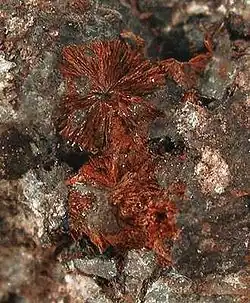Xocolatlite
| Xocolatlite | |
|---|---|
 Moctezuma Mine, Moctezuma, Municipio de Moctezuma, Sonora, Mexico | |
| General | |
| Category | Sulfate minerals |
| Formula | Ca2Mn4+2(Te6+O6)2 · H2O |
| IMA symbol | Xoc[1] |
| Strunz classification | 7.DF.85 |
| Crystal system | Monoclinic |
| Crystal class | Prismatic (2/m) (same H-M symbol) |
| Space group | P2/m |
| Identification | |
| Formula mass | 655.24 g/mol |
| Color | Chocolate brown |
| Crystal habit | Encrustations; Micaceous |
| Fracture | Conchoidal |
| Mohs scale hardness | 2-3 |
| Luster | Vitreous |
| Streak | Copper brown |
| Diaphaneity | Transparent |
| Specific gravity | 4.10 g/cc |
| Density | 4.1 g/cc |
| References | [2][3] |
Xocolatlite is a sulfate mineral named for its chocolatey appearance. Discovered in the La Bambolla gold mine of Moctezuma, Sonora, Mexico, Xocolatlite's name is derived from the Nahuatl word xocolatl (literally "bitter water"; a root word of "chocolate"), a drink made from cocoa, water, and chili.
References
- ^ Warr, L.N. (2021). "IMA–CNMNC approved mineral symbols". Mineralogical Magazine. 85 (3): 291–320. Bibcode:2021MinM...85..291W. doi:10.1180/mgm.2021.43. S2CID 235729616.
- ^ Xocolatlite mineral data from Webmineral
- ^ Mindat.org